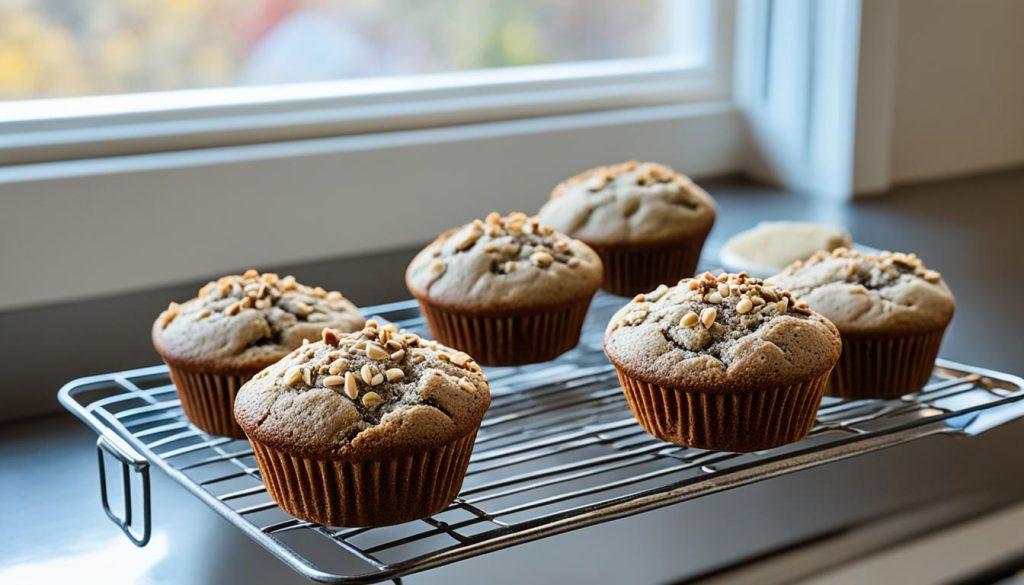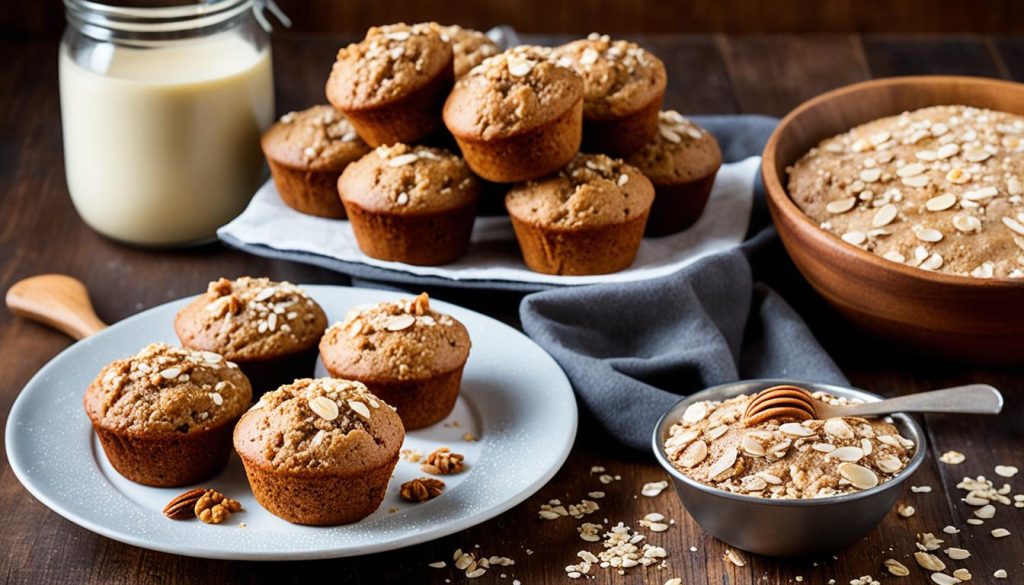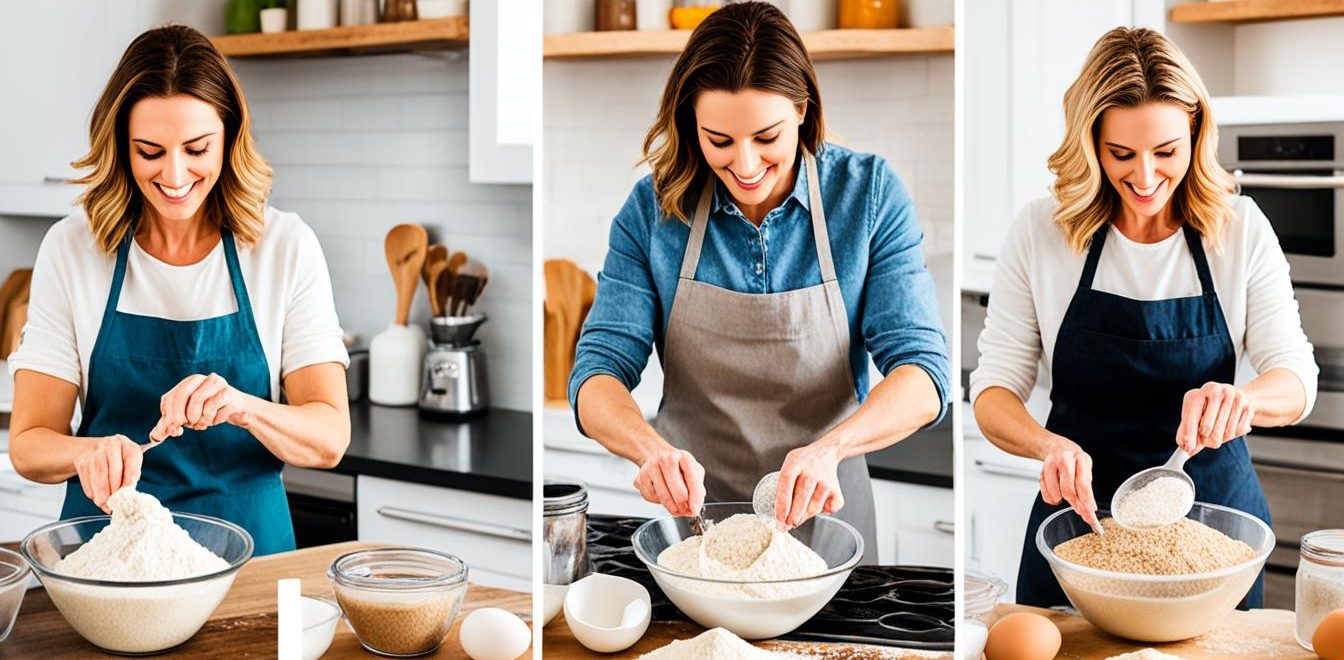Table of Contents
Are you tired of the same old baking routine? Looking to add a twist to your favorite recipes? It’s time to explore the world of alternative flours and discover a whole new realm of baking possibilities. From gluten-free options to unique and healthy alternatives, alternative flours can transform your baked goods into nutritious and delicious treats. But where do you start? And how do you use these non-traditional flours to achieve the best results?
Whether you’re searching for flour substitutions or innovative baking ideas, we’ve got you covered. In this article, we will guide you through the fascinating world of alternative flours and teach you how to incorporate them into your baking. Get ready to learn about gluten-free baking, discover unique baking flours, and find out how to create wholesome and tasty treats using alternative flour recipes.
So, are you ready to unleash your creativity in the kitchen and try something new? Let’s dive in and explore the wonders of baking with non-traditional flours!
Understanding Alternative Flours
Alternative flours offer a wide range of options for bakers who want to explore beyond traditional wheat-based flours. These flours can vary in properties, so it’s important to understand the differences before substituting them in recipes. Gluten-free flours, such as almond flour and coconut flour, are popular choices for those with dietary restrictions. Other unique flours like amaranth, buckwheat, and cassava offer different flavors and textures.
By familiarizing yourself with these flours, you can expand your baking repertoire and create delicious and innovative recipes.
Almond Flour – A Protein-Rich Substitute
Looking to incorporate alternative flours into your baking? Almond flour is a fantastic choice for gluten-free and low-carb baking. Made from ground raw almonds, it not only offers a nutty flavor but also provides a high protein and fiber content that can enhance the nutritional value of your recipes.
When using almond flour as a substitute for traditional flours, keep in mind that it absorbs more moisture. This means you may need to adjust the amount of flour used in your recipe to achieve the desired consistency. It’s always a good idea to start with a smaller amount and gradually add more as needed.
Almond flour is incredibly versatile and can be used in a variety of recipes. From cookies and cakes to pancakes, this alternative flour can bring a unique texture and taste to your baked goods. Plus, its gluten-free nature makes it suitable for those with dietary restrictions.
To give you a visual idea of the many delicious treats you can create with almond flour, here’s an example of mouthwatering almond flour muffins:
- Preheat the oven to 350°F (175°C) and line a muffin tin with paper liners.
- In a bowl, combine 2 cups of almond flour, 1/2 teaspoon of baking soda, and a pinch of salt.
- In a separate bowl, whisk together 3 large eggs, 1/4 cup of honey, 1/4 cup of melted coconut oil, and 1 teaspoon of vanilla extract.
- Pour the wet ingredients into the dry ingredients and mix until well combined.
- Gently fold in your favorite add-ins, such as blueberries or chocolate chips.
- Spoon the batter into the prepared muffin tin, filling each cup about 2/3 full.
- Bake for 20-25 minutes or until a toothpick inserted into the center comes out clean.
- Allow the muffins to cool for a few minutes before transferring them to a wire rack to cool completely.
These almond flour muffins are not only a delicious treat but also a gluten-free and protein-packed option. Enjoy them as a nutritious breakfast or satisfying snack!
Now that you know the benefits and versatility of almond flour in baking, why not give it a try in your own recipes? Experimenting with different alternative flours can help you discover new flavors and healthier options for your favorite baked goodies. So go ahead and explore the world of almond flour baking!
Amaranth Flour – A Nutrient-Rich Option
Amaranth flour, made from an ancient grain, is a versatile and nutrient-rich alternative flour. It is gluten-free and packed with essential nutrients, making it a popular choice for those looking for a healthy baking option.
This flour is rich in protein and amino acids, providing a great nutritional boost to your baked goods. It has a slightly earthy flavor that adds depth and complexity to your recipes.
Amaranth flour is often used in a 50:50 ratio with other flours to maintain the desired texture in baked goods. Its unique properties contribute to the overall structure and taste of the final product.
You can incorporate amaranth flour into a variety of recipes, including cookies, bread, and muffins. Its nutritional value and unique taste make it a great addition to any gluten-free baking repertoire.
To inspire you, here’s a recipe to try:
Amaranth Flour Chocolate Chip Cookies
- Ingredients:
- 1 cup amaranth flour
- 1/2 cup almond flour
- 1/2 teaspoon baking soda
- 1/4 teaspoon salt
- 1/2 cup unsalted butter, softened
- 1/2 cup coconut sugar
- 1/4 cup honey
- 1 egg
- 1 teaspoon vanilla extract
- 1/2 cup chocolate chips
- Preheat the oven to 350°F (175°C) and line a baking sheet with parchment paper.
- In a bowl, whisk together the amaranth flour, almond flour, baking soda, and salt.
- In a separate bowl, cream together the softened butter, coconut sugar, and honey until light and fluffy.
- Add the egg and vanilla extract to the butter mixture, and mix until well combined.
- Gradually add the dry ingredients to the wet ingredients, mixing until just combined.
- Fold in the chocolate chips.
- Drop spoonfuls of dough onto the prepared baking sheet.
- Bake for 12-15 minutes, or until the edges are golden brown.
- Allow the cookies to cool on the baking sheet for a few minutes, then transfer them to a wire rack to cool completely.
Enjoy these delicious and nutritious chocolate chip cookies made with amaranth flour!
Buckwheat Flour – A Nutty and Fiber-Rich Flour
Buckwheat flour is a versatile and gluten-free alternative that offers a unique flavor profile and nutritional benefits. Made from ground buckwheat, this flour is high in fiber and rich in vitamins, making it a healthy choice for your baking needs.
One of the key characteristics of buckwheat flour is its nutty taste, which adds a delightful depth of flavor to various recipes. Whether you’re making bread, pancakes, or other baked goods, incorporating buckwheat flour can elevate the taste and texture of your creations.
When using buckwheat flour, it can be substituted in a 1:1 ratio with other flours in recipes. However, it’s worth noting that using large amounts of buckwheat flour alone may result in a chalky texture. To achieve better baking outcomes, it is often combined with other flours, allowing you to enjoy the benefits of buckwheat while maintaining a desirable consistency.
To give your baking a fiber boost and explore the nutty flavors of buckwheat, try incorporating buckwheat flour into your gluten-free baking recipes. From hearty bread to fluffy pancakes, the possibilities are endless.

- Enhance the nutritional value of your baked goods with buckwheat flour.
- Add a nutty flavor to bread, pancakes, and other recipes.
- Combine with other flours for better consistency in baking.
- Experiment with gluten-free buckwheat flour recipes for healthier alternatives.
Discover the wonders of buckwheat flour in your gluten-free baking adventures and enjoy the unique flavors and health benefits it brings to your creations.
Cassava Flour – A Versatile and Gluten-Free Option
When it comes to gluten-free baking and alternative flours, cassava flour is a game-changer. Made from ground yuca root, cassava flour has gained popularity among those following a gluten-free or Paleo diet. This versatile flour offers a wide range of possibilities and can be used as a substitute for all-purpose flour in various recipes, including pancakes, cookies, and bread.
One of the unique characteristics of cassava flour is its ability to absorb more liquid than other flours. This means you may need to adjust the amount of cassava flour used in your recipes accordingly. It’s important to find the right balance to ensure the desired texture and consistency in your baked goods.
With cassava flour, you can enjoy all the benefits of a gluten-free diet without sacrificing flavor or texture. Whether you’re baking for yourself or catering to dietary restrictions, cassava flour provides a delicious and nutritious alternative. Its neutral taste makes it a versatile ingredient that can enhance both sweet and savory dishes.
So why not give cassava flour a try in your next baking adventure? Expand your culinary horizons and explore the world of gluten-free baking with this healthy and satisfying alternative flour.
Chickpea Flour – A Protein-Packed Flour
If you’re looking for a gluten-free alternative flour that is both nutritious and versatile, look no further than chickpea flour. Made from ground chickpeas, this flour is not only low in carbs but also packed with protein and fiber. Chickpea flour offers a slightly nutty flavor that adds a unique taste to your baked goods. Whether you’re thickening sauces, binding fritters, or even making pancakes, chickpea flour is a fantastic choice.
Chickpea flour is a fantastic choice for gluten-free baking and adds nutritional value to your dishes.
One of the great things about chickpea flour is its versatility. It can be used as a substitute for all-purpose flour in a variety of recipes, making it an excellent option for those with dietary restrictions. From crispy crusts to fluffy pancakes, chickpea flour can handle it all with ease.
Not only does chickpea flour provide a boost in protein, but it also adds a significant amount of fiber to your baked goods. This can help you feel fuller for longer and support a healthy digestive system.
When using chickpea flour in your recipes, it’s important to note that it has a denser texture compared to traditional flour. This means you may need to experiment with ratios and adjust the liquid content. However, once you find the right balance, you’ll be amazed at the delicious creations you can make with chickpea flour.
Benefits of Chickpea Flour in Baking:
- Gluten-free and suitable for those with gluten sensitivities
- High in protein and fiber
- Provides a slightly nutty flavor
- Can act as a thickener or binder in recipes
- Versatile and can be used in a variety of dishes
- Adds nutritional value to your baked goods
So go ahead and give chickpea flour a try in your next baking adventure. With its protein-packed goodness and unique flavor, you’ll be delighted with the results.
Coconut Flour – A High-Fiber and Low-Carb Option
If you’re following a low-carb or gluten-free diet, coconut flour is a fantastic option for your baking needs. Made from dried coconut, this alternative flour is not only delicious but also rich in fiber and low in carbs. With coconut flour, you can indulge in your favorite baked goods without compromising your dietary goals.
One thing to keep in mind when using coconut flour is that it has a unique quality of absorbing a lot of moisture in recipes. This can result in denser baked goods. However, with a few simple adjustments, you can achieve the perfect consistency and texture.
To counteract the absorbency of coconut flour, it’s crucial to add additional liquid or fat to your recipes. This will help maintain the desired consistency and prevent your baked goods from becoming too dry. Whether it’s coconut milk, eggs, or oil, experiment with different ingredients to find the best combination that works for you.
Coconut flour is incredibly versatile and can be used in a variety of recipes, ranging from bread and cookies to cakes and muffins. Its subtly sweet and nutty flavor adds a delightful tropical twist to your creations.
If you’re looking for some inspiration, here are a few coconut flour recipes to get you started:
- Coconut Flour Chocolate Chip Cookies
- Gluten-Free Coconut Flour Pancakes
- Coconut Flour Banana Bread
Don’t be afraid to get creative in the kitchen and explore the endless possibilities of coconut flour baking. It’s a fantastic way to enjoy your favorite treats while staying true to your healthy lifestyle.
A Healthy and Delicious Choice
Coconut flour is not only a nutritious choice but also a flavorful one. With its high fiber content and low-carb nature, it’s a versatile alternative for those seeking healthier baking options. So go ahead, give coconut flour a try in your recipes, and discover the delightful taste and benefits it brings to your table.
Oat Flour – A Nutritious and Versatile Flour
Oat flour, made from ground oats, is a nutritious and versatile flour that is high in fiber and slightly sweet in flavor. It’s a fantastic option for gluten-free baking and adding a healthy twist to your recipes. Oat flour can be easily made at home by grinding whole grain oats in a blender or food processor.
One of the main advantages of using oat flour is its nutritional value. It’s rich in dietary fiber, which helps with digestion and promotes a feeling of fullness. Additionally, oat flour contains essential vitamins, minerals, and antioxidants that contribute to overall well-being.
When it comes to baking, oat flour’s slightly sweet flavor adds a unique taste to your homemade bread, pancakes, and other baked goods. It can be used as a substitute for a portion of all-purpose flour, making your recipes healthier and more nutritious.
Take your oat flour baking adventures to the next level with these delicious oat flour recipes:
- Oat Flour Banana Bread
- Oat Flour Blueberry Muffins
- Oat Flour Chocolate Chip Cookies
By including oat flour in your baking repertoire, you can enjoy the benefits of this nutritious and versatile flour while creating delightful treats for yourself and your loved ones. Start experimenting with oat flour today and elevate your gluten-free baking game!
Rice Flour – A Gluten-Free Flour with a Nutty Flavor
Rice flour is a versatile and gluten-free alternative to traditional wheat-based flours. It is available in both white and brown varieties and offers a delicious nutty flavor that can enhance your baked goods. As a gluten-free flour, it is suitable for individuals with dietary restrictions or those looking for healthier baking options. Rice flour is also packed with fiber and protein, making it a nutritious choice for your recipes.
When using rice flour as a substitute for all-purpose flour, it’s important to note that it can produce a gritty texture. To overcome this, look for finely ground options or consider blending rice flour with other gluten-free flours to improve the consistency of your baked treats.
Rice flour is commonly used in various recipes, including dishes like fried calamari and tempura. Its ability to create a crispy, golden crust makes it a popular choice for batters and coatings. Whether you’re craving a delicious gluten-free snack or want to explore new culinary possibilities, rice flour can be a great addition to your pantry.
- Gluten-free baking
- Alternative flours
- Healthy baking
- Rice flour recipes
Try incorporating rice flour into your baking repertoire and enjoy the unique flavor and texture it brings to your favorite recipes. From cookies and cakes to savory dishes, rice flour is a versatile ingredient that can elevate your culinary creations. Explore the world of gluten-free baking and unleash your creativity with rice flour!
Whole-Wheat Flour – A Fiber-Rich and Nutritious Option
When it comes to healthy baking, whole-wheat flour is a top choice. This nutritious flour is made by grinding the entire wheat kernel, including the bran and germ, which provide essential fiber, vitamins, and minerals. With a higher fiber content compared to refined flours, whole-wheat flour is a healthier alternative that can support your well-being while still indulging in delicious baked goods.
Whole-wheat flour can be used as a substitute for all-purpose flour in your recipes. However, it’s important to note that it may result in a denser final product due to its unique characteristics. If you prefer a lighter texture, you can blend whole-wheat flour with all-purpose flour in a 1:1 ratio. This combination allows you to enjoy the health benefits of whole-wheat while achieving a desired fluffiness in your baked treats.
Whole-wheat flour is incredibly versatile and can be used in a variety of recipes. It’s commonly found in bread, muffins, and pancakes. You can also experiment with incorporating whole-wheat flour into your favorite cookie and cake recipes to add a nutritional boost. With its rich flavor and hearty texture, whole-wheat flour brings a delightful depth to your baked goods.
So why not try baking with whole-wheat flour? Explore the realm of healthy, alternative flours and discover the joy of creating fiber-rich and nutritious treats that you and your loved ones will savor.

Conclusion
Incorporating alternative flours into your baking can open up a whole new world of flavors, textures, and nutritional benefits. Whether you’re following a gluten-free diet or looking for healthier options, alternative flours provide a wide range of choices for your baking needs.
By experimenting with different flours, you can discover your favorites and create unique recipes that elevate your baked goods. From almond flour to buckwheat flour, each alternative flour offers its own distinct characteristics and can bring new dimensions to your creations.
With the knowledge and tips provided in this guide, you can confidently embrace the use of alternative flours in your baking journey. Explore the world of gluten-free baking or add extra nutrients to your recipes with these alternative flour options. Get creative and enjoy the delicious possibilities that alternative flours bring to your kitchen!

